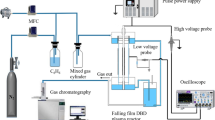Abstract
To improve the energy yield (EY) of plasma volatile organic compound decomposition, a dielectric barrier discharge plasma driven by pulse-modulated AC power was used to experimentally study the abatement of benzene in atmospheric pressure air and at room temperature. The effects of the duty cycle on decomposition efficiency, EY, CO2 selectivity and the formation of ozone and NO2 were investigated. The results show that applying pulse modulation improves the EY and the CO2 selectivity and greatly reduces the wall temperature of the reaction chamber.








Similar content being viewed by others
References
Einaga H, Ogata A (2009) Benzene oxidation with ozone over supported manganese oxide catalysts: effect of catalyst support and reaction conditions. J Hazard Mater 164:1236–1241
Karuppiah J, Linga Reddy E, Manoj Kumar Reddy P, Ramaraju B, Karvembu R, Subrahmanyam Ch (2012) Abatement of mixture of volatile organic compounds(VOCs) in a catalytic non-thermal plasma reactor. J Hazard Mater 237:283–289
Vandenbroucke AM, Morent R, De Geyter N, Leys C (2011) Non-thermal plasmas for non-catalytic and catalytic VOC abatement. J Hazard Mater 195:30–54
Odum JR, Jungkamp TPW, Griffin RJ, Forstner HJL, Flagan RC, Seinfeld JH (1997) Aromatics, reformulated gasoline, and atmospheric organic aerosol formation. Environ Sci Technol 31:1890–1897
Chorria J, Jaroniec M, Kloske M (2007) Ordered siliceous and carbonaceous nanomaterials in environmental protection. Ochr Srodowiska 29:3–12
Li W, Gong H (2010) Recent progress in the removal of volatile organic compounds by catalytic combustion. Acta Phys Chim Sin 26:885–894
Kumar A, Dewulf J, Van Langenhove H (2008) Membrane-based biological waste gas treatment. Chem Eng J 136:82–91
Demeestere K, Dewulf J, Van Langenhove H (2007) Heterogeneous photocatalysis as an advanced oxidation process for the abatement of chlorinated, monocyclic aromatic and sulfurous volatile organic compounds in air: state of the art. Criti Rev Environ Sci Technol 37:489–538
Masuda S (1988) Pulse corona induced plasmachemical process: a horizon of new plasma chemical technologies. Pure Appl Chem 60:727–731
Savinov SY, Lee H, Song HK, Na BK (2003) The effect of vibrational excitation of molecules on plasma chemical reactions involving methane and nitrogen. Plasma Chem Plasma Process 23:159–173
Penetrante BM, Hsiao MC, Bardsly JN, Merritt BT, Vogtlin GE, Kuthi A, Burhart CP, Bayless JR (1997) Identification of mechanisms for decomposition of air pollutants by nonthermal plasma processing. Plasma Sources Sci Technol 6:251–259
Wang H, Li D, Wu Y (2009) Removal of four kinds of volatile organic compounds mixture in air using silent discharge reactor driven by bipolar pulsed power. J Electrostat 67:547–553
Kim HH (2004) Nonthermal plasma processing for air-pollution control: a historical review, current issues and future prospects. Plasma Process Polym 1:91–110
Kim HH, Ogata A, Futamura S (2006) Effect of different catalysts on the decomposition of VOCs using flow-type plasma-driven catalysis. IEEE Trans Plasma Sci 34:984–995
Holzer F, Roland U, Kopinke FD (2002) Combination of non-thermal plasma and heterogeneous catalysis for oxidation of volatile organic compounds. Appl Catal B-Environ 38:163–181
Ming OJ, Shao FQ, Zou DB (2011) Numerical simulation of negative oxygen ion generation and temporal evolution in atmospheric plasma. Acta Phys Sin 60:110209
Kim HH, Oh SM, Ogata A (2005) Decomposition of gas-phase benzene using plasma-driven catalyst (PDC) reactor packed with Ag/TiO2 catalyst. Appl Catal B-Environ 56:213–220
Brehmer F, Welzel S, van de Sanden MCM, Engeln R (2014) CO and byproduct formation during CO2 reduction in dielectric barrier discharges. J Appl Phys 116:123303
Aerts R, Martens T, Bogaerts A (2012) Influence of vibrational states on CO2 splitting by dielectric barrier discharges. J Phys Chem C 116:23257–23273
Paulussen S, Verheyde B, Tu X, De Bie C, Martens T, Petrovic D, Bogaerts A, Sels B (2010) Conversion of carbon dioxide to value-added chemicals in atmospheric pressure dielectric barrier discharges. Plasma Sources Sci Technol 19:034015
Van Durme J, Dewulf J, Sysmans W, Leys C, Van Langenhove H (2007) Abatement and degradation pathways of toluene in indoor air by positive corona discharge. Chemosphere 68:1821–1829
Zhao G, Hu X, Argyle MD, Radosz M (2005) Effect of CO2 on nonthermal-plasma reactions of nitrogen oxides in N2. 1. PPM-Level Concentrations. Ind Eng Chem Res 44:3925–3934
John TH (2011) Modeling studies of the formation and destruction of NO in pulse barrier discharges in nitrogen and air. Plasma Chem Plasma Process 21:581–608
Kim HH, Ogata A (2011) Nonthermal plasma activates catalyst: from current understanding and future prospects. Eur Phys J Appl Phys 55:13806
Li Y, Fan Z, Shi J, Liu Z, Zhou J, Shangguan W (2014) Removal of volatile organic compounds (VOCs) at room temperature using dielectric barrier discharge and plasma-catalysis. Plasma Chem Plasma Process 34:801–810
Acknowledgments
This work was supported by the National Nature Science Foundation of China through Grant Nos. 11205007 and 11205029.
Author information
Authors and Affiliations
Corresponding author
Rights and permissions
About this article
Cite this article
Ma, T., Jiang, H., Liu, J. et al. Decomposition of Benzene Using a Pulse-Modulated DBD Plasma. Plasma Chem Plasma Process 36, 1533–1543 (2016). https://doi.org/10.1007/s11090-016-9736-z
Received:
Accepted:
Published:
Issue Date:
DOI: https://doi.org/10.1007/s11090-016-9736-z




